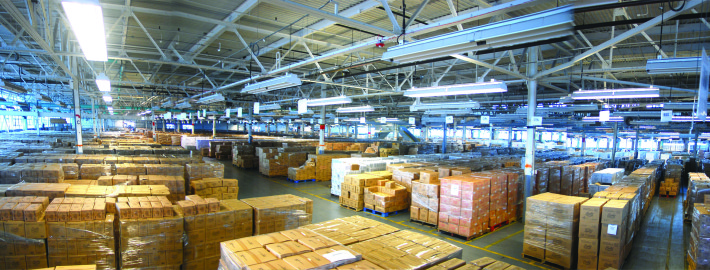Infrastructure of Retail Food Distribution Network Within North America
Infrastructure of Retail Food Distribution Network Within North America
Have you ever tried to consider how a fresh stack of vegetables and your favorite brand of groceries reach your nearest grocery store every week? Though the retail distribution network undergoes turmoil every few years to reduce operating costs and maintain growth of both small and large convenience store chains, warehouse retailers and single store grocery and convenience stores. In recent years retail distribution has witnessed a dramatic trend about growing control of retailers on supply chain which has helped to increase inventory turnover. Several large retailers are working with branded food producers to maintain direct store delivery which reduces number of distributors.
Supermarkets within North America have undergone a complete turnaround in the last couple of decades as regional and national supermarkets have moved from stocking only food products to complete convenience stores. Now wholesale food suppliers also distribute their products to major retailers which were not dealing in food like Walmart, 7-Eleven, Dollar Stores and 99 Cents only stores.
These chain stores now contribute nearly $ 381.7 million per annum to food retail sales and nearly 50 percent food distribution has shifted to alternative retail stores. Unfortunately this takeover of retail food industry by large convenience store chains has led to closure of traditional grocery stores located close to them due to lack of variety in their merchandise.
Besides Walmart Stores which is now among top 75 food retailers in North America with Kroger Co. and Costco Wholesale coming close in terms of turnover, other new retailers which have entered grocery product sales in a large way are Supervalu, Loblaw Cos. And Publix Super Markets to name a few. Wholesale grocery distributors have expanded their infrastructure to directly deliver produce to warehouses of large c-store chains and grocery store chains which take care of distribution and delivery to their stores themselves.
Grocery retailers are increasingly investing their products into increasing number of stores across the state and national boundaries instead of setting up distribution infrastructure. Retailers which have less infrastructure for food distribution can afford to give better prices to their customers in comparison to small retailers which have elaborate distribution chains.
Network of retail food infrastructure
Farmers markets – To connect farmers to consumers these markets are emerging as the best resource leading to growth by 54 percent since 2008 which has helped nearly 7000 farmers to connect with retailer chains and interact with consumers too. The USDA provides support to small and large farmers through several rural development programs to improve their produce and expand outreach to large markets.
Farmers are now able to interact with food processing firms to supply their output directly to them and also sell it in local markets which have been set up under community facilities grants. Food distributors also purchase their requirements on a regular basis and supply it to food service companies like restaurants, hospitals, schools and other food businesses. Regional farmers markets are being set up across rural farming areas which are close to high traffic areas to attract larger number of buyers.
Farmers’ cooperatives – To improve their bargaining power and grow their marketing strength farmers are setting up cooperatives which will also help them get better funding and grants from government agencies. Conservation and Development agencies which are working towards conservation of local industry and producers give financial assistance to these cooperatives to set up warehousing and cold storage facilities where their produce can be stored safely. Food wholesale suppliers also take delivery of their requirements from these cooperative warehouses and supply directly to small retailers, grocery store chains and also to food processing companies.
Centralized distribution and delivery – Under this system, manufacturers deliver their produce in large pallets to central warehouses located at key distribution centers which are then broken down into smaller pallets for distribution by vendors like convenience store brokers and grocery wholesale distributors across the nation. This system is ideal for manufacturers of processed food products and also for large farms making dairy products like cheese, yogurt, meat and butter. Food distribution networks in North America maintain their hubs around Los Angeles, Atlanta, Chicago and either New Jersey or Pennsylvania along with Toronto and Calgary.
Direct store delivery – Sometimes manufacturers of processed dairy products take the responsibility of delivering directly to convenience store chains through associations like Checkstand program which take the responsibility of launching products to customers along with delivery and sales. These distributors supply both regular and specialty foods to direct sales distribution network to major large and small retailers spread across the nation.
These channels help manufacturers bypass regular retailer and wholesaler distribution networks by moving goods directly from manufacturers’ warehouses to stores. Direct store delivery is profitable for perishable products which have short shelf life as products are in stores faster and there is nearly 10 percent reduction in costs.
Emerging trend in retail food distribution infrastructure
- Most top food retailers which had their own delivery networks to maintain quality and quantity of merchandise are now outsourcing their distributing needs to service providers like grocery store distributors and farmers’ cooperatives so they can concentrate on expanding number of stores in the region.
- Large supermarket chains like Target, Walmart, Costco and others have varied warehouses for food and non-food merchandise which also function as distribution centers for deliveries to their stores.
- With growing demand for online ordering and delivery of food products by restaurants, grocery stores are keen on having a similar facility of online food distributors which can take care of their needs at short notice.
- Mobile farmers markets which have cold storage facilities are going to areas where people do not have access to farmers markets and helping them gain access to fresh fruits and vegetables grown by local farmers in other parts of the state.
In recent years both traditional grocery retailers and grocery distribution centers have closed down due to competition from large retailers which have reduced distribution networks and are able to provide better prices to their buyers. But with improvement in supply chain technology and operational management some future ready supermarkets have managed to stay afloat.




